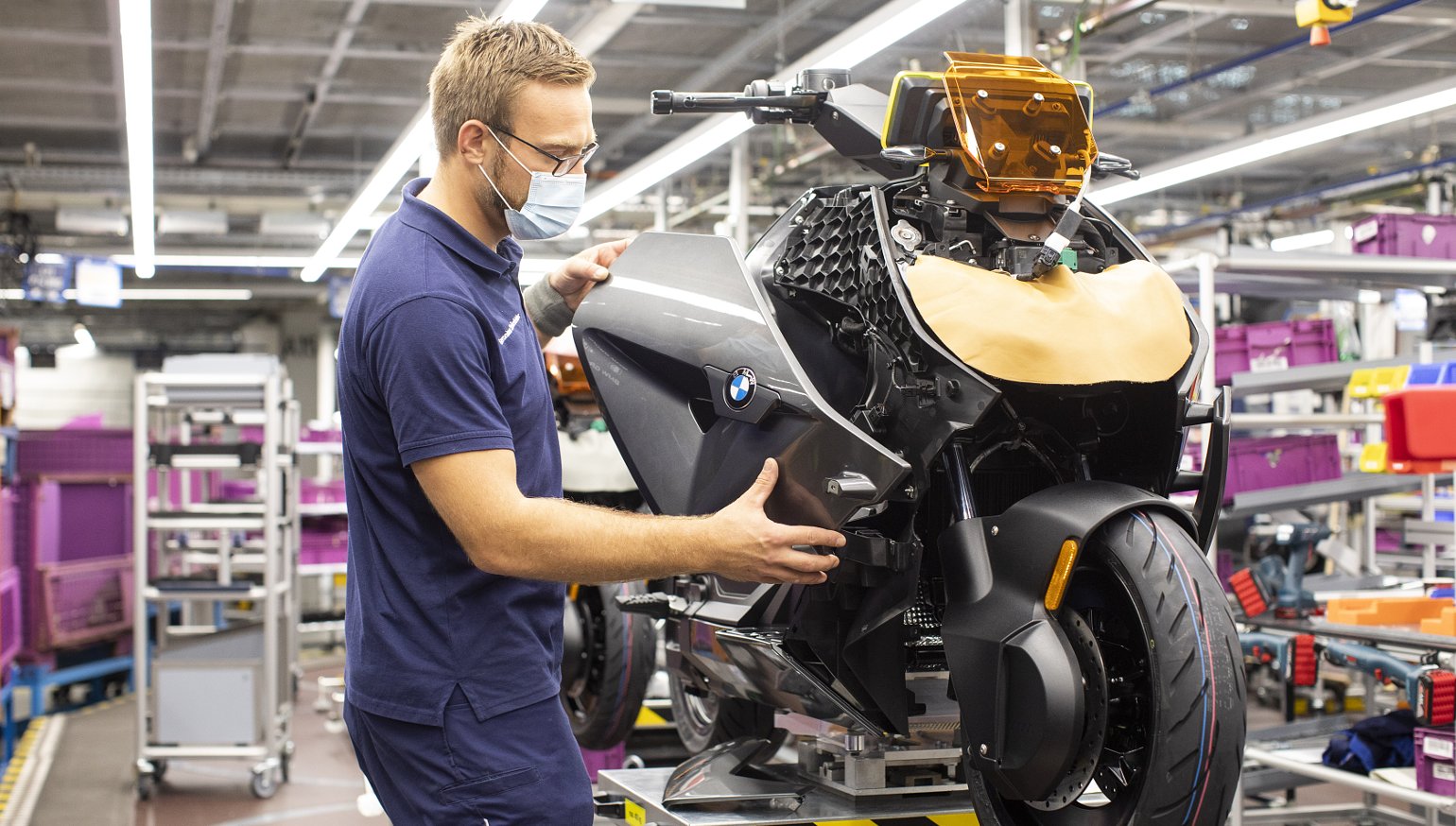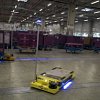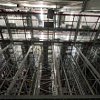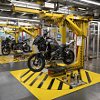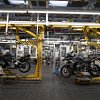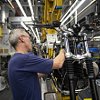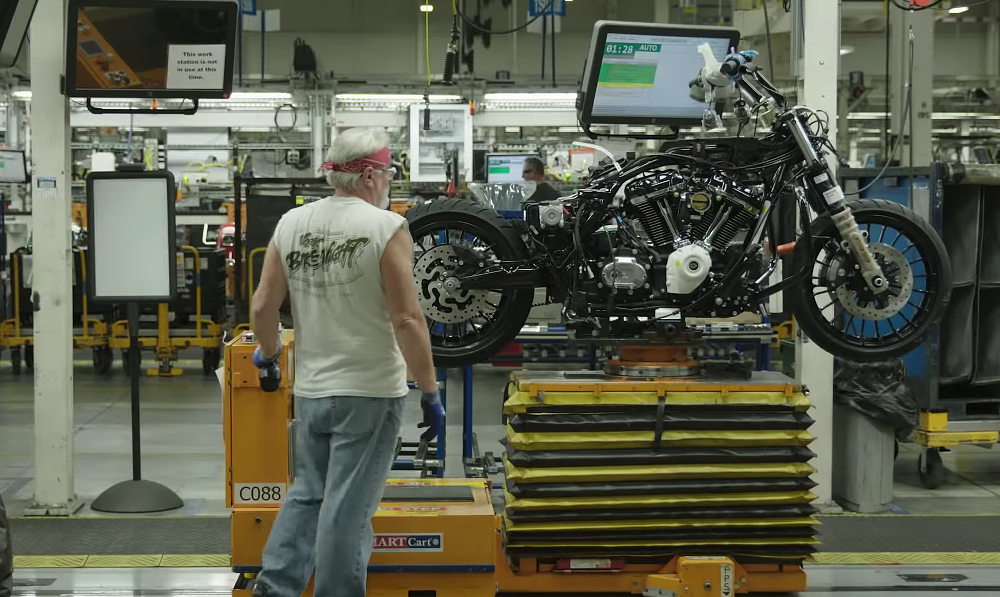For those of us who ride, a motorcycle factory is a dream factory. This is where the good stuff is made.

BMW handed me a hi-viz vest (ATGATT!) and an earpiece to help me hear the tour guide over the clamor of the factory floor. A short walk led to a plant entrance by the loading docks, where a line of trucks dropped off parts and raw materials. This cargo is automatically sorted and stored by one of the most fascinating systems in the entire plant: a new and entirely autonomous “high-bay” storage area that measures some 120 feet tall. Between these towering shelves, robotic elevators whizzed around with containers full of parts. These elevators could move both horizontally and vertically with astonishing speed as they stored and retrieved all kinds of motorcycle components.

With this system, only the computer knows where any given container sits on a shelf. There are no specific sections or divisions. Each inbound box is stored on the closest suitable shelf, its location is logged by the computer, and the parts sit there until they are needed. According to the tour guide, this seemingly chaotic approach was actually found to be the most efficient storage solution for BMW’s factory logistics. The only drawback, it seems, is that serious climbing gear is needed for service and maintenance.
Say a box of bolts is needed for one of the assembly lines. The computer logged the location of the relevant container when the automated elevators put them on the shelf, so an elevator is dispatched to get the bolts. It pulls the container off the shelf, whisks it down to ground level, and from there, the parts can be automatically sent to the production line. More than a million parts are moved within the facility each day. Engines and frames are paired ("married," in BMW's words) together, and then the hundreds of additional parts will be requested for immediate delivery from this area.
Robots and automation
So far, we haven’t encountered many of the plant’s employees. Their expertise is needed later on the assembly lines and testing stages. When it comes to simple, repetitive work like stocking shelves or hauling boxes between production lines, BMW is obsessed with optimization through robotics and automation. There’s even a robot to sort the mail. Human brainpower is better spent on the finer points of making motorcycles. I notice a repair shop full of parts and fixtures — people are needed to keep the automated machinery running, too.

The most common mobile robot type looks like an industrial scale on wheels with one long antenna. Each of these units is fully autonomous and capable of carrying over 500 pounds. It rolls underneath its cargo, lifts its main platform to reach the load, and trundles off to its assigned destination. The tour guide showed how the robot’s periphery sensors could detect a nearby worker or obstacle, slowing and eventually stopping until it was safe to move again. Small cargo robots sometimes roll aboard larger “tugger trains” for transportation across the factory on regularly scheduled timetables.

Elsewhere in the factory, complex components like crankshafts, connecting rods, fuel tanks, and frames are built in-house. Over 560 powertrains are built here each day. A typical engine takes about two hours to assemble as it makes its way through technicians and inspection stations. The engine’s critical parts are hand-fitted while each station’s computer logs every step. If the motorcycle experiences a problem at any point, BMW can review over 1,000 inspection points from the bike’s assembly process.
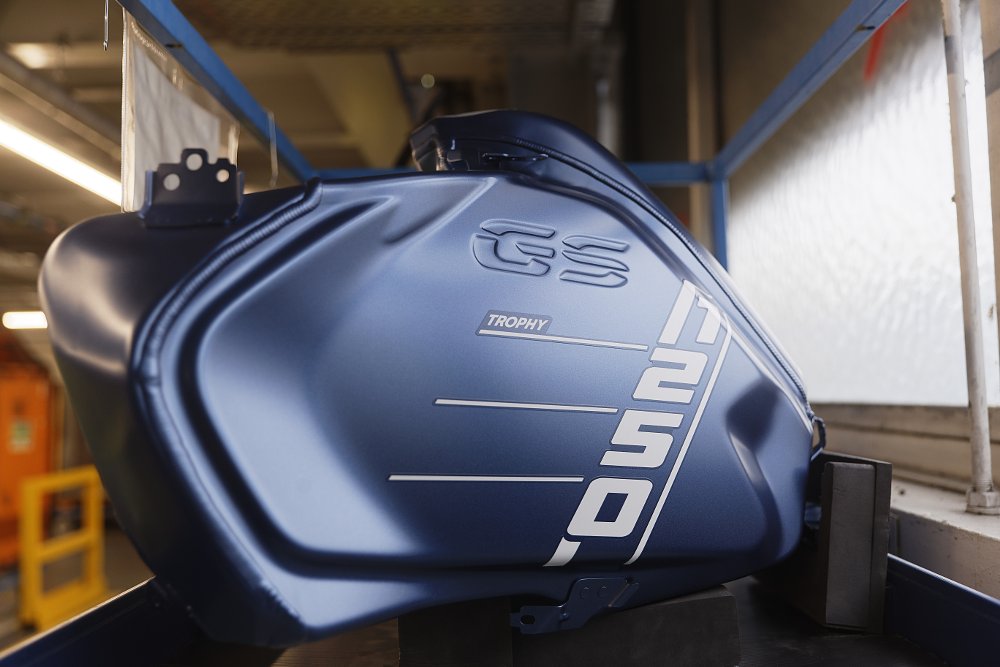
Other rooms I didn't see were the welding shop and paint shop. By this point, you won’t be surprised to hear that much of the welding and painting is done by robotic arms. Each piece of bodywork is built to order and tagged so that it will only be installed on one specific bike. Racks and racks of freshly painted pieces were lined up for installation as the tour reached the start of the production line.

Bare frame to finished
A large yellow support called a C-hook reaches down from a track on the ceiling to hold the married engine and chassis, the beginnings of a new motorcycle. The C-hook and track carry the motorcycle through all the assembly stations on its production line. When factory workers swipe their cards to start each shift, the yellow hook’s height adapts to each worker’s height preference automatically for optimum ergonomics. Even the factory floor materials are tailored to reduce workplace strains and injuries. Other devices are used to aid lifting and positioning hefty components like wheels.

The tour follows the C-hooks as workers add wiring harnesses, gas tanks, wheels, handlebars, and headlights. All the parts to be installed with a particular bike travel with it on racks. If you've ever taken a BMW motorcycle or car apart, you'll find stamps and markings on nearly every piece. The equipment at the factory is the same way. Every container, cart, and shelf had a label. A place for everything, and everything in its place.

Over at the CE 04 assembly line, frames receive battery packs and motors instead of engines. Workers have been trained to assemble the new model using a combination of in-person training and augmented reality (AR) self-training. Special goggles overlay the user's vision with instructions, warnings, procedures, and even torque values in real time. BMW says AR will allow staff to rapidly learn their way around new models at any time. That may come in handy soon as BMW adds in-house EV manufacturing capabilities.
The motorcycles leaving the end of the assembly line look unfinished, and there's a good reason for that. Easily scratched parts like windshields, mirrors, and fairings are not installed until after the final dyno run. Inspectors try every function on each motorcycle, then run through the gears and the entire rev range for one last check. Coolant and fuel systems are tested for leaks long before this part of the process, but one last fluid check is also on the list.

Most of the motorcycles built in the Berlin plant are exported to other markets. The completed bikes are crated, loaded onto trucks, and shipped to customers around the world. However, some workers in Berlin have managed to build their own motorcycles with some clever shift scheduling. Not a bad perk.
As completed bikes are wheeled away for crating, I have the sudden urge to rub my eyes. I realize I haven't blinked in a while as I tried to take in this experience that was somehow even more... BMW than I expected.

Environmental impact and sustainability
BMW's focus on efficiency at the Berlin plant benefits more than production volume and workplace safety. Ecological impact also matters, especially as zero-emission vehicles take on a larger role in the brand's future planning. That's why BMW's 2030 CO2 targets call for a 20 percent reduction in supply chain emissions and an 80 percent reduction in emissions during production. The plant already produces all of its own electricity using one of the largest generators in the city. A third goal calls for 100,000 electric two-wheelers to be sold in the next eight years. Development of more efficient ICE engines will continue in tandem, and BMW did not indicate any plans to step away from gasoline power entirely.
How to visit BMW's Berlin factory
If you're ever in Berlin, and you enjoy motorcycles, I think it's well worth the trip across town for a tour of the Berlin factory. BMW has a well deserved reputation for quality, craftsmanship, and industrial complexity, and I was still shocked at the processes involved in the creation of Motorrad products. Of course, my experience is slightly colored by the connection to one of my personal bikes, but whether you ride a Honda, a Harley, or a Hyosung, I think the tour will be worth your time.
Guided plant tours run from 9 a.m. to 8 p.m., Monday to Friday. Later tours starting at 7.30 p.m. are also available with reservation. Email info@bmw-besuchen.com, or visit bmw-werk-berlin.de to learn more.




